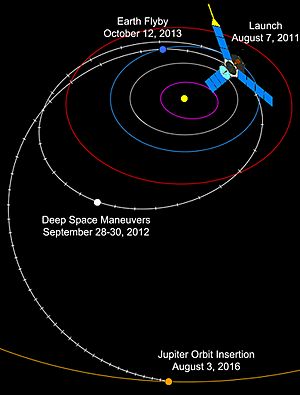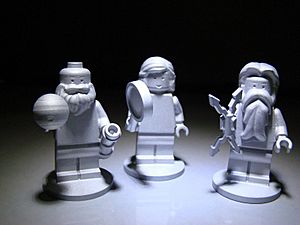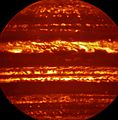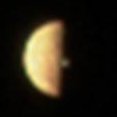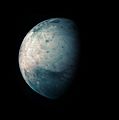Juno (spacecraft) facts for kids
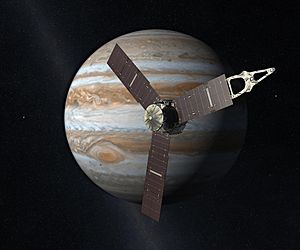
Artist's rendering of the Juno spacecraft at Jupiter
|
|
| Mission type | Jupiter orbiter |
|---|---|
| Operator | NASA / JPL |
| Website |
|
| Mission duration | Planned: 7 years Elapsed: 13 years, 8 months, 4 days Cruise: 4 years, 10 months, 29 days Science phase: 4 years (extended until July 2021) |
| Spacecraft properties | |
| Manufacturer | Lockheed Martin |
| Launch mass | 3,625 kg (7,992 lb) |
| Dry mass | 1,593 kg (3,512 lb) |
| Dimensions | 20.1 × 4.6 m (66 × 15 ft) |
| Power | 14 kW at Earth, 435 W at Jupiter 2 × 55-ampere-hour lithium-ion batteries |
| Start of mission | |
| Launch date | August 5, 2011, 16:25 UTC |
| Rocket | Atlas V 551 (AV-029) |
| Launch site | Cape Canaveral SLC-41 |
| Contractor | United Launch Alliance |
 Juno mission insignia New Frontiers program
|
|
Juno is a NASA space probe orbiting the planet Jupiter. It was built by Lockheed Martin and is operated by NASA's Jet Propulsion Laboratory. The spacecraft was launched from Cape Canaveral Air Force Station on August 5, 2011 (UTC), as part of the New Frontiers program, and entered a polar orbit of Jupiter on July 5, 2016 (UTC), to begin a scientific investigation of the planet. After completing its mission, Juno will be intentionally deorbited into Jupiter's atmosphere.
Juno's mission is to measure Jupiter's composition, gravity field, magnetic field, and polar magnetosphere. It will also search for clues about how the planet formed, including whether it has a rocky core, the amount of water present within the deep atmosphere, mass distribution, and its deep winds, which can reach speeds up to 618 kilometers per hour (384 mph).
Juno is the second spacecraft to orbit Jupiter, after the nuclear powered Galileo orbiter, which orbited from 1995 to 2003. Unlike all earlier spacecraft sent to the outer planets, Juno is powered by solar arrays, commonly used by satellites orbiting Earth and working in the inner Solar System, whereas radioisotope thermoelectric generators are commonly used for missions to the outer Solar System and beyond. For Juno, however, the three largest solar array wings ever deployed on a planetary probe play an integral role in stabilizing the spacecraft as well as generating power.
Juno's name comes from Greek and Roman mythology. The god Jupiter drew a veil of clouds around himself to hide his mischief, and his wife, the goddess Juno, was able to peer through the clouds and reveal Jupiter's true nature.
Juno was originally proposed at a cost of approximately US$700 million (fiscal year 2003) for a launch in June 2009. NASA budgetary restrictions resulted in postponement until August 2011, and a launch on board an Atlas V rocket in the 551 configuration. As of June 2011[update], the mission was projected to cost US$1.1 billion over its life.
Scientific objectives
The Juno spacecraft's suite of science instruments will:
- Determine the ratio of oxygen to hydrogen, effectively measuring the abundance of water in Jupiter, which will help distinguish among prevailing theories linking Jupiter's formation to the Solar System.
- Obtain a better estimate of Jupiter's core mass, which will also help distinguish among prevailing theories linking Jupiter's formation to the Solar System.
- Precisely map Jupiter's gravitational field to assess the distribution of mass in Jupiter's interior, including properties of its structure and dynamics.
- Precisely map Jupiter's magnetic field to assess the origin and structure of the field and how deep in Jupiter the magnetic field is created. This experiment will also help scientists understand the fundamental physics of dynamo theory.
- Map the variation in atmospheric composition, temperature, structure, cloud opacity and dynamics to pressures at all latitudes.
- Characterize and explore the three-dimensional structure of Jupiter's polar magnetosphere and auroras.
- Measure the orbital frame-dragging, known also as Lense–Thirring precession caused by the angular momentum of Jupiter, and possibly a new test of general relativity effects connected with the Jovian rotation.
Galileo plaque and Lego minifigures
Juno carries a plaque to Jupiter, dedicated to Galileo Galilei. The plaque was provided by the Italian Space Agency and measures 7.1 by 5.1 centimeters (2.8 by 2.0 in). It is made of flight-grade aluminum and weighs 6 grams (0.21 oz). The plaque depicts a portrait of Galileo and a text in Galileo's own handwriting, penned in January 1610, while observing what would later be known to be the Galilean moons.
The spacecraft also carries three Lego minifigures representing Galileo, the Roman god Jupiter, and his sister and wife, the goddess Juno. The Juno minifigure holds a magnifying glass as a sign of searching for the truth, and Jupiter holds a lightning bolt. The third Lego crew member, Galileo Galilei, has his telescope with him on the journey. The figurines were produced in partnership between NASA and Lego as part of an outreach program to inspire children's interest in science, technology, engineering, and mathematics (STEM). Although most Lego toys are made of plastic, Lego specially made these minifigures of aluminum to endure the extreme conditions of space flight.
Images for kids
-
Animation of Juno's trajectory around Jupiter from 1 June 2016 to 25 October 2025 Juno · Jupiter
-
Ganymede, photographed on 7 June 2021 by Juno during its extended mission
-
Jupiter imaged using the VISIR instrument on the VLT. These observations will inform the work to be undertaken by Juno.
-
Galileo Galilei plaque
-
Low resolution view of Io captured by JunoCam (September 2017)
See also
 In Spanish: Juno (sonda espacial) para niños
In Spanish: Juno (sonda espacial) para niños


